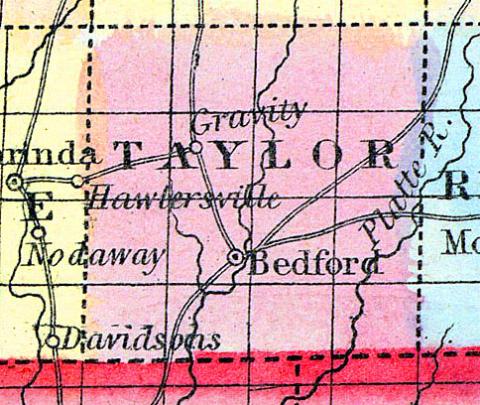BEDFORD the seat of justice of Taylor County, was located in March, 1852, by commissioners appointed for that purpose, by an act of the General Assembly of the State of Iowa. It is situated on the southwest quarter of the southwest quarter of section twenty-six, township 68, north of range 34 west, and on the west side of the river, 102. The ground on which it is situated, is a piece of second bottom land, very convenient to water and stone, and surrounded by beautiful farm land. The ground on all sides rising something in the form of an amphitheatre affords many prominent and beautiful sites for building suburban cottages, and when the town shall have been built to a reasonable size and the land within view of the place shall have been put into cultivation and adorned with cottages, orchards and shade trees, Bedford will be one of the most attractive towns in southwestern Iowa. The town was first surveyed soon after its location, but the land on which it is located was not entered for more than a year afterward. The first sale of lots took place July 4th, 1852. No persons attended the sale except the farmers of the county. A barrel of whisky was on the ground, and after they had drank freely the sale commenced, and most of the lots surveyed were sold at prices varying from ten to twenty dollars. But not a single lot was paid for, or title, or title bond given, and if any record was kept of the sale it is not to be found among the records of the county. It is but just, however to remark that these sales were regarded by the parties as binding upon themselves, and were so treated in nearly every instance. The first house in Bedford was erected by O. W. Fenno, Esq., on the corner of Main and Water street. It was a double log house, designed, and for several years used as a store and a dwelling, and is still standing being used for a stable. The second house was a small dwelling, built of hewn logs, by Edwin Houck, on the opposite side of Main street from the one erected by Squire Fenno. Catharine Fenno, a daughter of 0. W. Fenno, was the first child born in Bedford, and is still living here. About the only improvement made during the year 1854, was the building of a double log house by the firm of Thornton and Cadle, in which was kept a small stock of dry goods, groceries, etc. Early in the spring of 1856, the town commenced settling with eastern people, and in less than two years from that time the inhabitants numbered over four hundred. Since that time there has been no increase either in the number of buildings, or of inhabitants. This is owing in part to the fact that from speculative motives the town was pushed ahead faster than the settlement and improvements in the county would justify, and partly to the agitation of the county seat question. Very fortunately, however, both for the prosperity of the town and county, this “vexed question” is now permanently settled, and henceforward we look for a steady and permanent growth. Bedford now contains a good court house built of stone, a good capacious church built by a common fund, raised by the citizens, which is under the charge of the Baptist denomination, but free to all other denominations when not used by them; two good saw mills, a flouring mill, five general stores, two drug stores, a tin and hardware store, two blacksmith shops a harness shop, several groceries, boot and shoe shops, tailor shops, etc. It also contains a Masonic Lodge, No. 156, which holds its regular communications on the Wednesday evening preceding the full moon. There is also a Lodge of the I. O. O. F., No. 91, and a flourishing Lodge of the I.O.G. T., which meets regularly on Monday evening; and the prohibitory liquor law of Iowa is pretty thoroughly enforced. There is also a local newspaper, The National Express, published by H. S. Erman. (Hair's Iowa State Gazetteer..., 1865)

